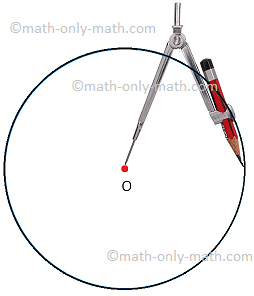Solving a Linear Inequation Algebraically
Method of Solving a linear inequation algebraically ax + b >, <, ≥, ≤ cx + d
To solve a given linear inequation means to find the value or values of the variable used in it.
Thus; (i) to solve the inequation 4x + 7 > 23 means to find the variable x.
(ii) to solve the inequation 12 – 5y ≤ 17 means to find the variable y and so on.
On the basis of the laws of the inequality, we have the following working rules:
I: Rule of transferring a positive term: If we transfer a positive term (the term in addition) from one side of an inequations to its other side, then the sign of the term becomes negative.
For example:
1. 3x + 5 > 9 ⟹ 3x > 9 - 5
2. 7x + 2 ≤ 29 ⟹ 7x ≤ 29 - 2
3. 14 ≥ 3x + 11 ⟹14 - 11 ≥ 3x and so on.
II: Rule of transferring a negative term: If we transfer a negative term (the term in subtraction) from one side of an inequations to its other side, then the sign of the term becomes positive.
For example:
1. 3x - 5 > 9 ⟹ 3x > 9 + 5
2. 7x - 2 ≤ 29 ⟹ 7x ≤ 29 + 2
3. 14 ≥ 3x - 11 ⟹14 + 11 ≥ 3x and so on.
III: Rule of multiplication/division by a positive number: If we multiply or divide by the same positive number to each term of an inequation then, the sign of inequality remains the same.
i.e., All terms on both sides of an inequality can be multiplied or divided by a positive number.
Case I: If k is positive and m < n
m < n ⟹ km < kn and \(\frac{m}{k}\) < \(\frac{n}{k}\),
m > n ⟹ km > kn and \(\frac{m}{k}\)> \(\frac{n}{k}\),
m ≤ n ⟹ km ≤ kn and \(\frac{m}{k}\) ≤ \(\frac{n}{k}\),
and m ≥ n ⟹ km ≥ kn and \(\frac{m}{k}\) ≥ \(\frac{n}{k}\).
Thus, x ≤ 10 ⟹ 5x ≤ 5 × 10
x ≥ 7 ⟹ 20x ≥ 20 × 7
x ≤ 17 ⟹ \(\frac{x}{2}\) ≤ \(\frac{17}{2}\) and so on.
IV: Rule of multiplication/division by a negative number: If we multiply or divide by the same negative number to each term of an inequation then, the sign of inequality reverse.
i.e., All terms on both sides of an inequality can be multiplied or divided by a negative number on reversing the inequality.
Case II: If k is negative and m < n
m < n ⟹ km > kn and \(\frac{m}{k}\) > \(\frac{n}{k}\),
m ≥ n ⟹ km ≤ kn and \(\frac{m}{k}\) ≤ \(\frac{n}{k}\)
Thus, x ≤ 10 ⟹ -5x ≥ -5 × 10
x > 12 ⟹ -5x < -5 × 12
x ≥ 7 ⟹ -20x ≤ -20 × 7
x ≥ 17 ⟹ \(\frac{x}{-22}\) ≤ \(\frac{17}{-22}\) and so on.
V: If we change the sign of each term on both sides of an inequation, then the sign of inequality gets reversed.
For example:
1. - m> 10 ⟺ m < -10
2. 5t ≤ 19 ⟺ -5t ≥ -19
3. -9k < - 5 ⟺ 9k > 5 and sso on.
VI: If both the sides of an inequation are positive or both are negative, then on taking their reciprocals, the sign of inequality reverses.
That is, if m and n both are either positive or both are negative, then
(i) m > n ⟺ \(\frac{1}{m}\) < \(\frac{1}{n}\)
(ii) m ≤ n ⟺ \(\frac{1}{m}\) ≥ \(\frac{1}{n}\)
(iii) m ≥ n ⟺ \(\frac{1}{m}\) ≤ \(\frac{1}{n}\) and so on.
Using the above facts we take the following steps to solve linear equations ax + b > cx + d.
Step I: bring all terms containing the variable (unknown) x on one side and the constants on the other side by using rules I and II.
Step II: Put the inequation in the form px > q.
Step III: Divide both sides by p by using rule III and IV.
From Solving a Linear Inequation Algebraically to HOME
Didn't find what you were looking for? Or want to know more information about Math Only Math. Use this Google Search to find what you need.
Recent Articles
-
Dividing 3-Digit by 1-Digit Number | Long Division |Worksheet Answer
Apr 24, 24 03:46 PM
Dividing 3-Digit by 1-Digit Numbers are discussed here step-by-step. How to divide 3-digit numbers by single-digit numbers? Let us follow the examples to learn to divide 3-digit number by one-digit nu… -
Symmetrical Shapes | One, Two, Three, Four & Many-line Symmetry
Apr 24, 24 03:45 PM
Symmetrical shapes are discussed here in this topic. Any object or shape which can be cut in two equal halves in such a way that both the parts are exactly the same is called symmetrical. The line whi… -
Mental Math on Geometrical Shapes | Geometry Worksheets| Answer
Apr 24, 24 03:35 PM
In mental math on geometrical shapes we will solve different type of problems on simple closed curves, polygons, basic geometrical concepts, perpendicular lines, parallel lines, circle, terms relates… -
Circle Math | Terms Related to the Circle | Symbol of Circle O | Math
Apr 24, 24 02:57 PM
In circle math the terms related to the circle are discussed here. A circle is such a closed curve whose every point is equidistant from a fixed point called its centre. The symbol of circle is O. We… -
Fundamental Geometrical Concepts | Point | Line | Properties of Lines
Apr 24, 24 12:38 PM
The fundamental geometrical concepts depend on three basic concepts — point, line and plane. The terms cannot be precisely defined. However, the meanings of these terms are explained through examples.




